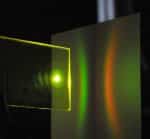Researchers in the USA have found a new way of concentrating solar energy without using lenses or mirrors. Utilising a unique process which causes “amnesia” in light waves, nanoscientists from the Department of Energy’s (DOE) Argonne National Laboratory say they can enhance the amount of light directed onto solar cells, thus improving efficiency and lowering the cost of solar power.
The team used inexpensive plastic slabs called luminescent solar concentrators (LSCs), which have the ability to absorb light and re-emit it at much higher intensities. As researcher Chris Giebink explains, luminescent solar concentrators have significant advantages over conventional solar concentration methods, which are often required to track the sun over the course of a day.
"LSCs act kind of like flat funnels – we try to absorb a lot of light over the face of a plastic slab filled with dye, and then re-direct it all back out the edges."
Unlike a lens magnifying system, LSCs are comprised of a layered nanostructure made up of micro-cavities which produce a "resonance shifting" effect, whereby the structure of the material simulates the wavelength of light, causing light waves to effectively forget their original source.
"It really is like giving light amnesia – if light forgets how it came in, it’s less likely to get reabsorbed or scattered out," Argonne Laboratory’s Gary Wiederrecht says.
Until now, the team has been unable to utilise the technology to its full potential. They have yet to reach the elusive concentrated photovoltaic (CPV) industry standard of 100 suns – one sun equalling the measure of solar radiation at noon on a sunny day.
But Giebink believes it is possible to obtain better resonance-shifting effect and therefore better solar efficiency by putting more research into two-dimensional LSC analysis.
"We’ve demonstrated the general principle, now we just have to find the best pattern of dye thicknesses or alternatively the best way to vary the thickness of the glass."
Source/image source












































